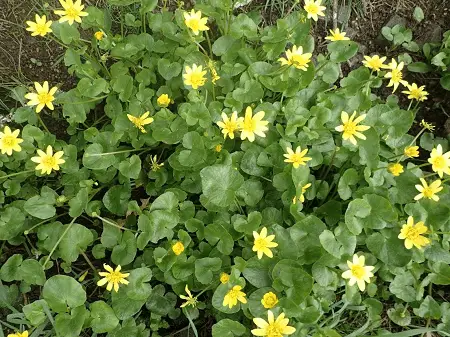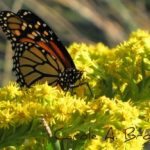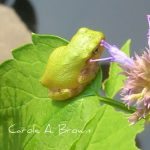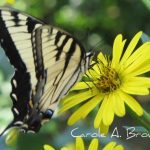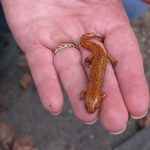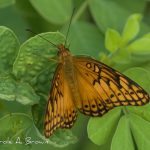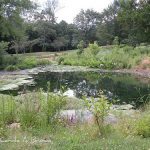Winter is over, now it’s time for the native spring ephemeral wildflowers, those that grow, flower, and reproduce before the woodland trees leaf out. But, thanks to some of the worst of the most hated plants, some invasive plants prevent this from happening.
One of these is Ranunculus ficaria (Lesser Celandine, Fig Buttercup). Now, you may be thinking “Oooh, pretty buttercups.” But this plant has some nasty habits that are destroying native spring ephemeral wildflowers.
The leaves appear in late winter, forming a dense mat which prevents the growth of almost every other plant. In the photo below, you’d be surprised to know that this mat is blocking out even the English Ivy that forms a second mat below this plant. You can see that the only thing growing through the mat of Lesser Celandine is Star of Bethlehem (another invasive plant which we’ll talk about in a later post).
The good news is that Ranunculas ficaria can be easily pulled from damp ground. However, notice the little tubers that form the root area of this plant. You MUST remove all of those tubers to control this plant.
Ranunculus ficaria spreads by underground tubers which must be removed to control this plant
This can be very laborious work in your garden, digging it up and sifting out the tubers. It’s a herculean task to stop the spread of this plant through larger natural areas.
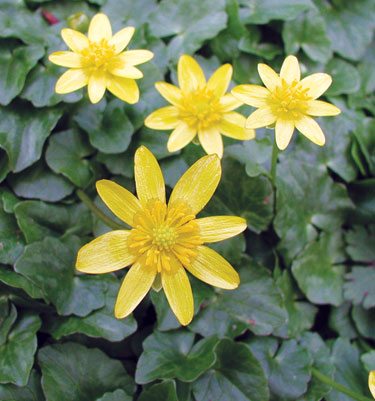
Fig Buttercup was introduced to the US as an ornamental plant. Even though this plant is considered invasive in 17 states from Wisconsin to Rhode Island and south to Tennessee, it is still available for sale in those states.
Plant breeders have developed many colorful cultivars, which should be considered just as invasive as the species.
Some examples of native spring ephemerals include bloodroot, wild ginger, spring beauty, harbinger-of-spring, twinleaf, squirrel-corn, trout lily, trilliums, Virginia bluebells, and many, many others. These plants provide critical nectar and pollen for native pollinators, and fruits and seeds for other native insects and wildlife species. Because fig buttercup emerges well in advance of the native species, it has a developmental advantage which allows it to establish and overtake areas rapidly.
If you garden has a wet area, one alternative to Lesser Celandine is Marsh Marigold (Caltha palustris), which has a similar appearance and bloom time.
Another alternative for upland areas is Wood Poppy (Stylophorum diphyllum), also known as Celandine Poppy, which is blooming in my garden at the same time as the Lesser Celandine in my neighbor’s garden.
Leave Us Your Comments Below!
Click the Submit Your Comments button below to leave us your comments, questions, or feedback!
More From Ecosystem Gardening:
Submit your review | |
Good article, but please, use italics when writing the scientific names of plants. Articles have the power to educate people.
Let's do that.
Another point is that I find weird the amount of effort and the damage to the ecosystem when people use pesticides to get rid of invasive species (such as this) that continue to be legally sold in the garden centres. It makes no sense.
Signed, a concerned biologist
Good description of how it starts our cute then becomes a monster taking over everything. Concentrated liquid Iron also does a great job at killing this week.
I am very interested in Chris's combination of 2 ingredients to kill Fig Buttercup . It has taken over the creek bottom & is starting on the yards in my neighborhood .
what kind of plants survive when spraying this combo?
The only thing I know of to use kills everything .
We have done several years of research here in Oregon on eradicating this weed. There are two herbicide formulations that when combined do a number on this weed. Imazapyr, we use the aquatic approved version; ecomazapyr, and milestone which is aminopyralid. You will need to read labels and decide on rates and see what works in your situation; but when combined and using a good surfactant, we get one shot-one kill.
Will you please advise how to get rid of these invasive plants without poison to the birds and bees and other animals and insects?

